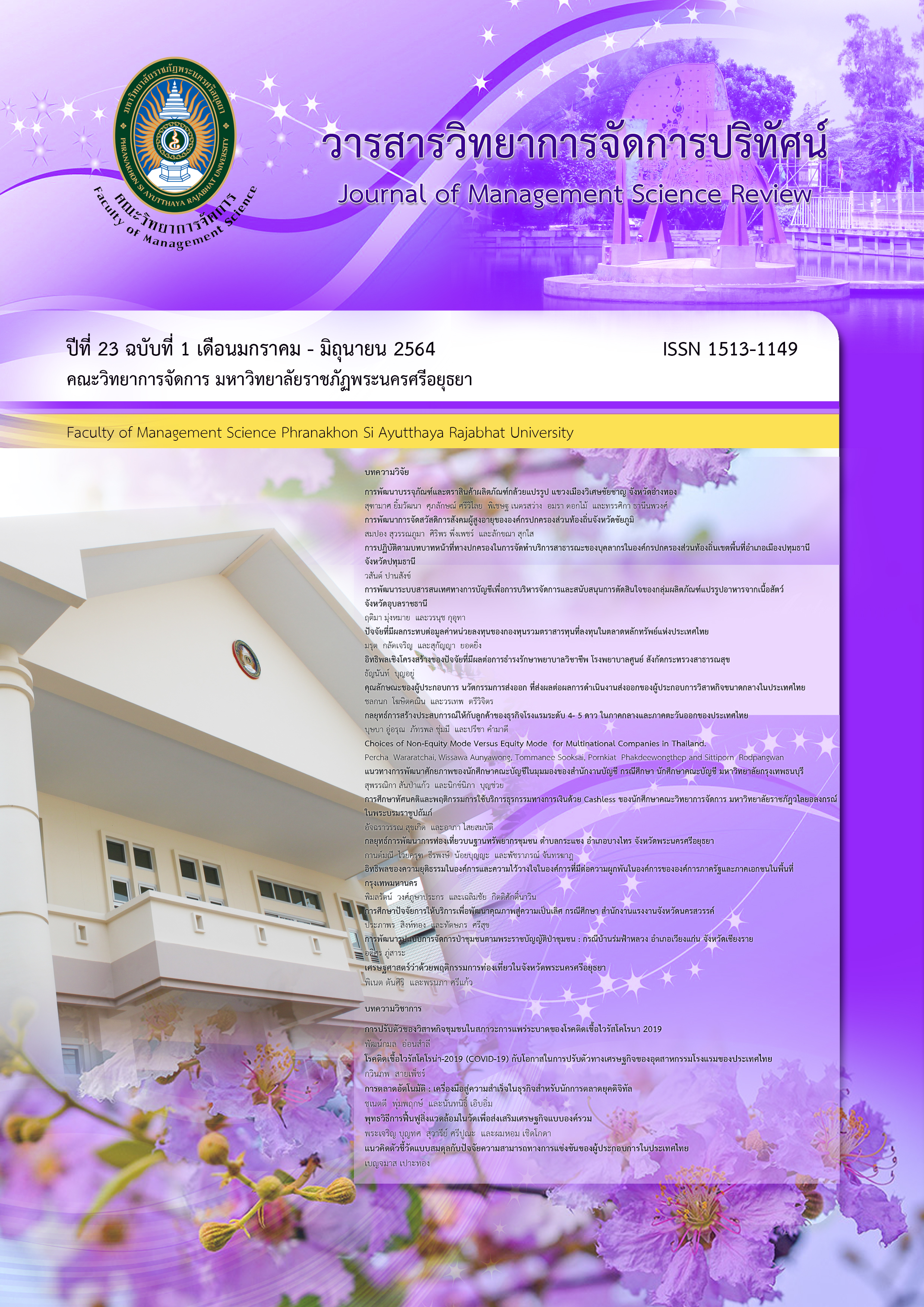Entrepreneurial Orientation and Export Innovation Affect on Export Performance of Entrepreneurs for Medium Enterprises in Thailand
Keywords:
Entrepreneurial Orientation, Export Innovation, Export PerformanceAbstract
This study aims to study the characteristics of entrepreneurs in export innovation, affecting the export performance of medium-sized enterprises in Thailand. Data were collected using questionnaires from 338 medium-sized enterprises in Thailand. Data analysis included multiple correlation analysis and multiple regression analysis. The findings were as follows: 1) Entrepreneur orientation consisted of innovation creation, risk exposure, and proactive tend to have influence on export innovation and export performance, and 2) innovation in exports. Export, product innovation, process innovation, and behavioral innovation have directly impact on export performance. The results in this study showed that medium-sized enterprises should be those who are committed to innovation in exports, such as setting a vision, transferring knowledge to employees, being enterprising, and having continuous exchange of learning in order to achieve the organization's objectives in overseas export markets.
References
บุญชม ศรีสะอาด. (2545). การวิจัยเบื้องต้น (พิมพ์ครั้งที่ 7). กรงเทพฯ: สุวีริยาสาส์น
รติมา คชนันทน์. (2558). Academic Focus. กรุงเทพฯ: สำนักงานเลขาธิการสภาผู้แทนราษฎร.
รายงานสถานการณ์วิสาหกิจขนาดกลางและขนาดย่อม. (2560). สำนักงานส่งเสริมวิสาหกิจขนาดกลางและขนาดย่อม. ค้นเมื่อ 15 สิงหาคม 2560, จาก http://www.sme.go.th/th/index.php/
วิฬารี สว่างพลกรัง. (2561). รูปแบบการพัฒนานวัตกรรมการส่งออกของผู้ประกอบการวิสาหกิจขนาดกลางและขนาดย่อมในประเทศไทย. ดุษฏีนิพนธ์บริหารธุรกิจบัณฑิต สาขาบริหารธุรกิจ, มหาวิทยาลัยกรุงเทพธนบุรี.
วรเทร ตรีวิจิตร. (2562, กรกฎาคม-ธันวาคม). กลยุทธ์ทางการตลาดและนวัตกรรมการส่งออกที่ส่งผลต่อผลการดำเนินการส่งออกธุรกิจอาหารทะเลขนาดเล็กในประเทศไทย. วารสารวิทยาการจัดการปริทัศน์, 21(2),
สมบัติ ท้ายเรือคำ. (2552). ระเบียบวิธีวิจัยสำหรับมนุษยศาสตร์และสังคมศาสตร์. กาฬสินธุ์: ประสานการพิมพ์
Covey, S. R. (2004). Seven habits of highly effective People. Free Press.
Deshpande, R. and Webster, F.E. (1989). Organizational culture and marketing: Defining the research agenda. Journal of Marketing, 53,3-15.
Hair, J. F., Black, W. C., Babin, B. J., Anderson, R. E. and Tatham, R. L. (2006). Multivariate data analysis (7 ed.).
New Jersey: Pearson.
Hult, G. T. M., Hurley, R.F. and Knight, G.A. (2004). Innovativeness: Its antecedents and impact on business performance. IndustrialMarketing Management, 33, 429-438.
Leonidou, L.C. (2004). An analysis of the barriers hindering small business export development. Journal of
Small Business Management, 42(3),279- 302.
Lin, C. Y. (2007). An examination of implementing customer relationship management by Chinese-Owned SMEs. Master’ thesis of Commerce & Management, Lincoln University.
Porter, M. E. (1990). The Competitive Advantage of Nations. London: Macmillan.Rauch, A., Wiklund, J., Lumpkin, G. T. and Frese, M. (2009). Entrepreneurial Orientation and Business Performance: An Assessment of past
Research and Suggestions for the Future. Entrepreneurship Theory & Practice, 33(3), 761-787.
Slater, S. F. and Narver, J. C. (1995, July). Market Orientation and the learning Organization. Journal of Marketing, 59 (3), 63-74.
Stevenson, N. (1998). Disused shrimp ponds : Options for redevelopment of mangrove. Coastal Management, 4, 423-425.
Weerawardena, J. and Mort, G.S. (2006). Investigating social entrepreneurship: A multidimensional model.
Journal of World Business, 4(1), 21–35.




